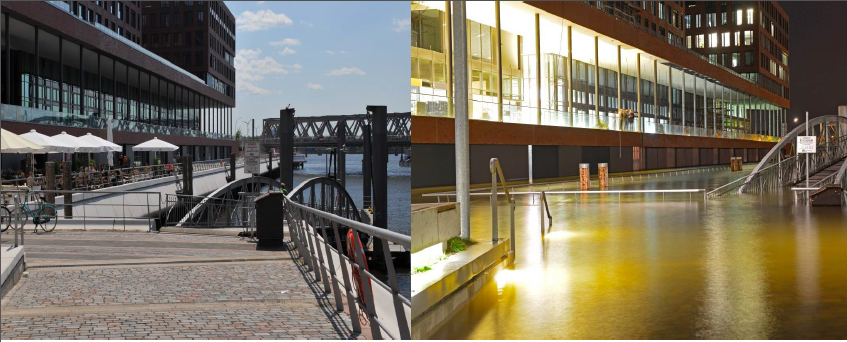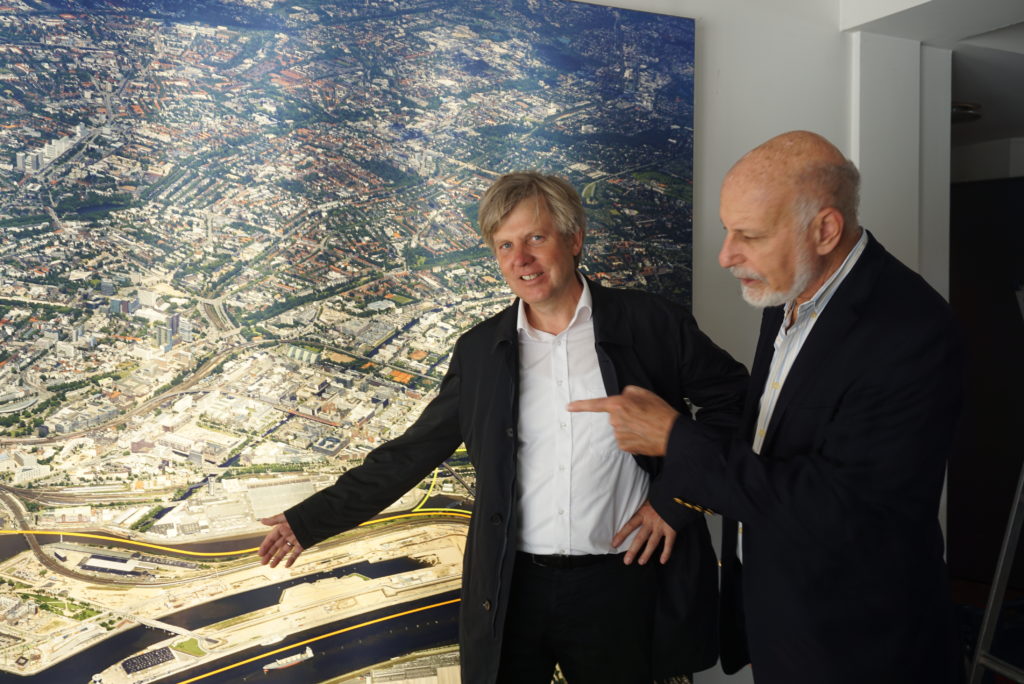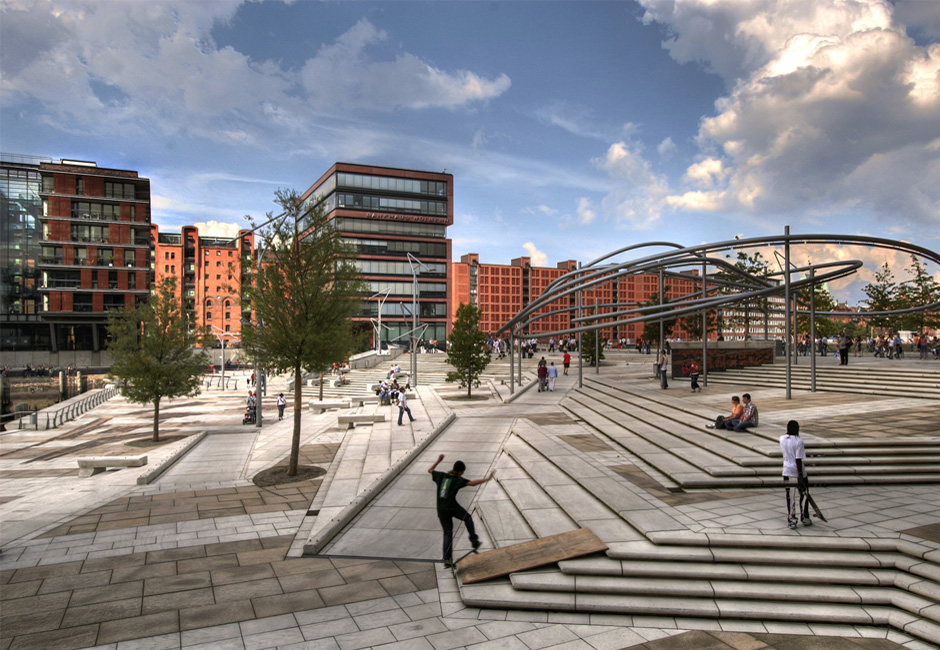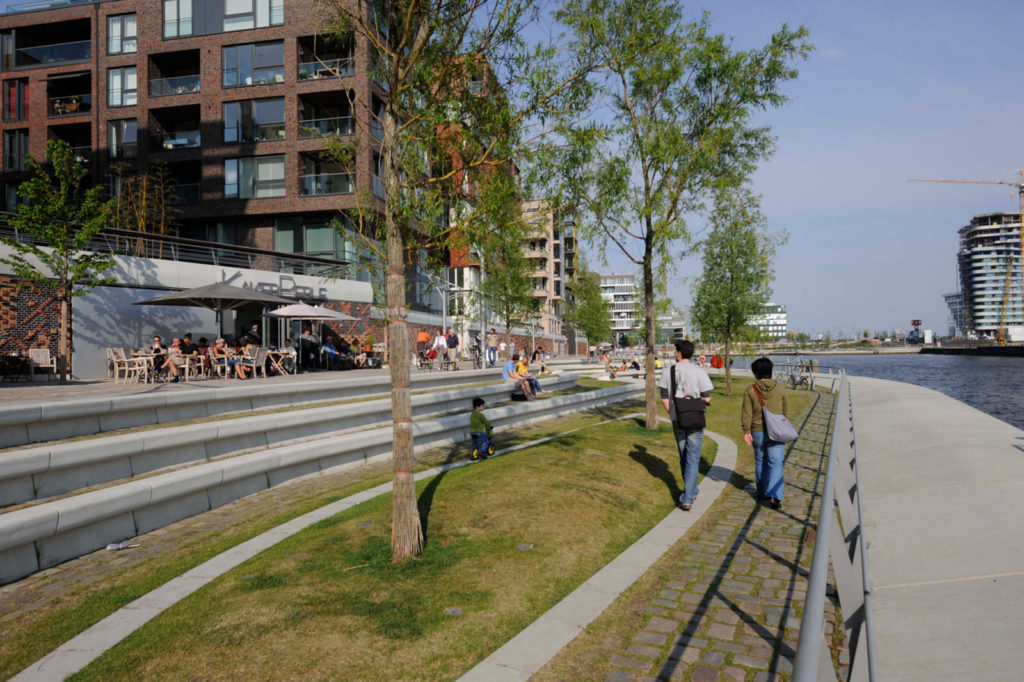Boldest City Design I’ve Seen For Flood Resiliency

A restaurant plaza under normal and severe flood conditions in HafenCity. Clever design makes the city “flood proof” with short term flooding in the present era, and suggest ways to design for sustained rising sea level in the coming decades.
Recently while in Europe, I got to tour a new city designed for flood waters more than thirty feet above sea level. Though it is mostly designed for extreme tidal rise, I thought it might suggest some ways to design for rising sea level, which will add to the usual short term flood events from storms, heavy rain, and extreme tides.
I was given a biking tour of HafenCity by the senior project manager, Jürgen Rux. It was such a nice place I extended my stay an extra night. It’s location will surprise most, in the shadow of global headlines last week. Historic Hamburg––Germany’s second largest city–– was in the news a few days ago for the meeting of the G20 leaders. There was political drama, riots, confrontations about climate change, and more. Just a few hundred feet away from that scene in the old city of Hamburg, is HafenCity, which in English translates to Harbor City.
This new community in Hamburg is designed for 14,000 residents, on 388 acres, a little more than half a square mile. HafenCity is an exciting new urban environment that is glowing with professional and popular praise. Of particular interest to me, it is designed to be essentially flood proof. And their flood planning is not like the timid height of two or three feet that I commonly hear about as stretching the limits of good design. In HafenCity, residential elevations are all a minimum of thirty one feet (9.5 meters) above sea level. (Projects must also commit to the Gold standard for energy efficiency.) As illustrated at top, the commercial areas, including restaurants and plazas are designed to withstand short term flooding with watertight flood doors for the storm driven floods that recede within hours.

Over its thousand year history, Hamburg has had to learn to cope with massive flooding due to the way the North Sea pushes up the Elbe River. Routine high tides move up and down ten feet, but frequent storm surges add another ten feet of water. The old port city solved the problem with an imposting dike that has been enhanced over the centuries. That wall has kept the historic Hamburg functioning, but the wall impedes view of the river that was a feature of the city.
Future facing HafenCity is nearly complete just twenty years after the concept was first proposed. Thriving Hamburg — Europe’s third largest port––needed to expand. Growth would have to deal with the routine river flooding and the old protecting dike wall There was an old industrial area just outside the dike. A visionary plan saw the potential to add 40% to Hamburg’s area with an expedited design and approval process. HafenCity is the solution.
Fundamentally, it involved substantially raising the base ground elevation heights, differentiating residential, from plazas with dining, public spaces, and emergency corridors. Each has different engineering criteria, taking into account whether short term flooding is acceptable. As shown in the images above promenades with restaurants are designed with flood barrier doors that can slide into position when flood waters are expected. This is similar to the way that Florida residents might use temporary hurricane shutters for wind protection.
Rather than the steep walls of the old Hamburg style dike, the new design of HafenCity features many stepped surfaces and publics areas that are designed to flood such as the examples below.
Designing cities to be practical enjoyable places to live and work, knowing that sea level will rise five to ten feet this century is something that all coastal communities need to consider. HafenCity’s approach is not a solution for all places that will flood in the future. It would not be possible, for example, to raise all of Florida or Vietnam the same way that this half square mile of Hamburg was elevated. But for many dense urban areas, HafenCity has provided a great functional example of landscape architecture and design. It can help us look over the “wall” to think of new approaches that can function through the era when the sea will be five to ten feet higher. The sooner we begin to design and adapt the better. Those that invest in future oriented designs now will reap the benefits far into the future.
For more information about HafenCity. [click]


